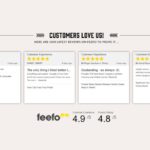Retailers that take the time to strike up conversations with existing and potential customers stand out in the IRUK Top500 Brand Engagement Dimension. By providing information or inspiration that’s of real value to shoppers, these traders make a sale a little more likely.
Here, Chloe Rigby rounds up 12 highly practical approaches that leading retailers are taking as they find new ways to open conversations with customers
1. Put brand experience to the fore
The way that shoppers want to buy can be just as important to them as what they want to buy – and this can vary by generation. Retailers that think through the implications of how their customers want to buy their brands have come up with some very different approaches to doing business. Made.com, for example, has brought together a digital-first experience with showrooms in the UK and in Europe, as it looks to show its wares to shoppers in the way that best suits them.
Customers who visit the showroom can browse goods almost in the same way as they might online, scanning QR codes to find out more about the item, while at the same time being able to touch, feel and test out a sofa or chair.
Speaking as the company unveiled plans for expansion across Europe, chief creative officer of Made.com, Jo Jackson, explained its approach. “Being a digitally native brand, online will always come first for us, but we know a human connection with the brand can be a valuable midpoint in our customer journey. We are doing something different with our physical spaces.
They are not shops, they are brand experiences. Being able to touch and feel fabrics, discover new trends, get personal style advice, attend a workshop with one of our independent designers, or even play with new tech we are testing out in the space, these are all steps to build a deeper and more personalised relationship with our customer.”
2. Find new approaches to loyalty
Retailers win return visits and sales from their customers when they reward them for being loyal. Top500 retailers have taken a number of different approaches to this. Marks & Spencer, for example, has used gamification in its M&S Sparks loyalty programme. More than 7m customers have now signed up to the scheme, which gives shoppers their own choice of discounts and enables them to earn extra incentives as they engage with the brand.
Hotel Chocolat, meanwhile, has offered discounts, birthday gifts and other customer incentives in a new VIP Me rewards card initiative that it says will help it to build deeper relationships with its customers. Hotel Chocolat said in half-year results published in February 2018 that it had seen half a million new customers sign up to the card in the months following its launch.
3. Leverage utility
Features that are innately useful can help to boost shopper engagement with a trader or brand, bringing them back for something they find genuinely handy to have around. John Lewis’ iOS app features a ‘kitchen drawer’ where receipts for items bought are automatically saved. Amazon customers, meanwhile, can see all of their previous orders when signed into their account – and can reorder an item with a single click.
Traders including Clarks and Mothercare provide e-receipts, helping consumers ensure they don’t lose the all-important proof of payment, while the retailers benefit from improving their view of the customer data.
4. Use new technologies to answer questions
Retailers that use technology to provide automatic conversations with shoppers enable them to get fast answers to easily answered questions, while customer service staff can focus instead on callers whose issues are more complex. Both Amazon and Very use chatbots to answer straightforward questions relating to areas such as orders and delivery, but shoppers are offered the option of speaking to a member of staff if necessary.
Ocado, meanwhile, uses machine learning to sort incoming queries so that its contact centre staff can deal with them more easily.
5. Deploy reviews and ratings strategically
When retailers go beyond simply sharing their reviews and ratings, they can attract customers’ attention and inspire them to trust the brand. Shoppers can see the independent evidence that a retailer is trustworthy and choose for themselves.
Guitar and musical instrument retailer Andertons Music Co isn’t shy about sharing its feedback. It boasts, “Customers love us!” on its home page, and demonstrates the point by sharing its latest Feefo reviews and star ratings, warts and all, above its Feefo ratings for customer experience and products.
6. Make space to talk
Giving customers the space and place to talk can help them find new ways to use a product they already have, or be inspired that a product is the right one for them to buy. Community forums enable browsers to ask questions of others who share their interests, and find problem-solving recommendations.
There are several examples of such forums across retail categories. Department store Debenhams’ Beauty Club combines a very active community forum with the chance to try out free samples, win prizes and build up points towards purchases. Members discuss products and share recommendations and images of how a product looked on them.
Over at the Screwfix community forum, meanwhile, conversations range from extending pipes to choosing scaffold towers. Insights gained through such conversations are not only useful to those taking part, but also to those who subsequently browse conversations as they look for answers to their own questions.
For example, DIY customers can eavesdrop on tradespeople talking through tricky jobs, which is a useful way to access professional insights.
7. Use images to engage customers
A picture’s worth a thousand words, so retailers can get their messages across by sharing images on social media that best represent the brand. Instagram is no longer just for fashion retailers. In 2019, 81% of Top500 retailers use the channels to share inspiring images and videos.
Andertons Music chooses stylish images of guitars and other musical instruments, while Aldi uses its account to share inspiring food images and videos.
8. Use new ways to engage
Asian fast food chain Wasabi has used mobile to deliver a ‘smart packaging’ marketing play. When it launched its new Home Bento range in 200 branches of Sainsbury’s, packaging featured a unique QR code that shoppers could scan in order to enter a competition to win a trip to Japan.
Alternatively, they could type the one-off short URL into a web browser to enter the code featured on the ready meal packaging. The promotion uses technology from Thyngs to effectively turn packaging into a new engagement channel. Thyngs’ analytics platform can in turn tell Wasabi who is picking up their ready meals at Sainsbury’s and, as each competition entry code is unique, whether they are coming back for more.
Wasabi already uses Thyngs’ near-field communication (NFC) technology in its frictionless Wasabi Club loyalty scheme. Andreia Harewood, senior marketing manager at Wasabi, said of the initiative: “Using Thyngs was a no-brainer as we had already run a successful loyalty programme with them and knew they would deliver both great service and fantastic returns.”
Thyngs CEO Neil Garner said this represented “an entirely new channel of engagement” that would also give Wasabi insights into its customers along with their preferences.
9. Give shoppers good reasons to sign up
New retail models are evolving as brands sign shoppers up to regular deliveries though subscriptions. Graze, with its through-the-door healthy snack boxes, was one of the early entrants to a market that Royal Mail says will be worth £1bn a year by 2022.
Graze has now been bought by Unilever, which hopes to learn more about the model and how it could work for its other brands. The model has successfully been applied to beauty, by Birchbox, while Pets at Home started by offering a regular flea powder subscription for dog and cat owners, and is now expanding this idea to other treatments.
Last year, the pet supplies retailer said that subscription helped it to drive 75% growth in omnichannel revenues. Shoppers who signed up to join its VIP Puppy Club got incentives, including a month’s free flea treatment subscription and a free vet nurse check, and spent 25% more on its goods and services as a result.
Meanwhile, more people are signing up to delivery subscription schemes that include free next-day delivery and returns for a set annual fee. Shoppers benefit because they have the certainty of free fulfilment once the initial fee is paid, while retailers benefit as shoppers keep coming back to buy for just that reason.
The IMRG UK Consumer Home Delivery Review 2018/2019 found that 46% of respondents were members of a delivery loyalty scheme in 2018, up from 29.7% in 2017.
10. The role of the store in brand awareness…
Around 18% of retail sales currently take place online – leaving around 80% that take place in stores. The store plays an important part in offering shoppers the convenience of buying and taking away immediately, or of picking up an online order.
But just as important, it’s a reminder to shoppers of what the retailer represents. Established multichannel retailers such as Boots and Marks & Spencer continue to have a presence on high streets and in shopping centres across the UK, while for emerging retailers such as Quiz, stores play an important awareness-raising part in their expansion.
Pop-up stores from online players, including eBay and Etsy, have played an important role in raising brand awareness, while giving shoppers the chance to experience the brand in a more immediate way. Other online retailers have opened up within larger department stores. Swoon Editions, for example, has showcased its furniture within branches of Debenhams to good effect.
11. …and in brand experiences
Bringing events into store helps to create communities that are still more social, in a place where it’s easy to then go on to buy. By hosting events, retailers put their name front of mind when shoppers need to buy a product. Thus Lululemon hosts yoga classes, Rough Trade has in-store gigs, Waterstones frequently hosts talks from authors, and John Lewis holds a range of workshops to share best approaches to a number of tasks.
12. Use content alongside commerce
Retailers that provide editorial-style content on their transactional websites go a long way to give shoppers context. By suggesting how the items they sell might fit into readers’ lives, retailers can inspire, explain, and show through the deft use of lifestyle imagery how products might be used in practice.
Marks & Spencer offers advice through its Style & Living section, where recent features focused on outfits for a children’s playdate, wearing more colour, a 2019 approach to the midi skirt, and bringing spring into the home. Editorial pieces feature links to shop the look or a sign-up to a daily newsletters. The Burberry site, meanwhile, takes an image-led approach to features on areas from gift suggestions through to, recently, a collection that marked the Chinese New Year.
By providing more actively engaging content, retailers keep shoppers’ attention and boost the chances of them returning to the website to read and discover more.







